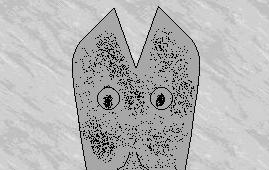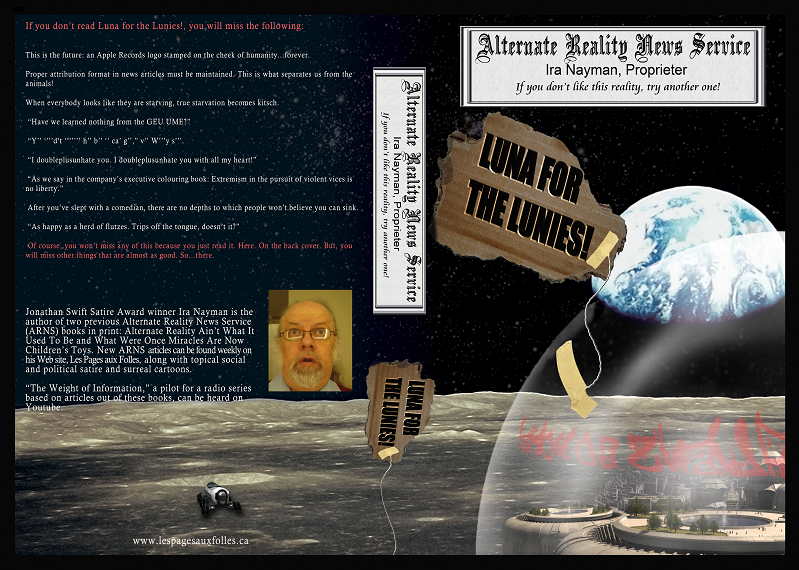by LAURIE NEIDERGAARDEN, Alternate Reality News Service Medical Writer
Apostrophosis. It’s the literary disease that nobody wants to talk about.
It’s starts simply enough. You want your billboard to say: “Nothing gets by Greta,” but, instead, it says “Nothing get’s by Greta.” The box for your toothpaste should read, “Crest for kids,” but it actually reads “Crest for kid’s.” It’s embarrass’ing.
“I can understand the Crest mix-up,” stated Warren von Winky, head of literary surgery at Boston’s renowned Kennedy Medical Centre and Intellectual Salon. “The copywriter obviously confused the plural and the pos’s’es’s’ive. The Fox News’ billboard…well, that’s a different kettle of haggis.”
Apos’trophos’is’ is one of many illnesses on the Obs’essive Punctuation Disorder S’pectrum. Other diseases of the literary mind run from the relatively benign Ellipse Elevation S’yndrome to the almost always fatal Comma Coma. The various illness’es are generally dis’crete, although cases of writers with more than one as’pect of the Spectrum, mostly from the 16th century, are known to exis’t.
Literary medical res’earchers have identified at least two strains of apos’trophos’is. Apostrophos’is’ A is a relatively minor condition that is easily treatable with a strict reading regimen of 19th century novels. It can lead to embarras’sment in certain s’ocial circles, but that’s about it. It is believed that William S’hakespeare suffered from this mild form of apos’trophosis’.
Apos’trophos’is’ B, on the other hand, is’ a much more virulent s’train of the di’s’order which, if not immediately diagno’s’ed and treated, can lead to the end of even the most promis’ing literary career. There has’ never been a documented case of Apos’trophosis B, likely because’e even the most experimental publi’s’her is’n’t likely to put out a book that is’ almos’t entirely made up of a single punctuation mark.
“At the dis’eas’e’s wor’s’t,” von Winky explained, “a common English word like ‘interregnum’ could appear as’ ””’rr””’.’ A’s’ you might imagine, that can make it very difficult to write a report on the drop in la’s’t quarter’s earnings’!”
“Oh, it’s’ not as’ bad as’ it ‘s’ounds,” said Ches’ter Bus’hmins’ter (apparently, that is the s’pelling of hi’s’ name – Bus’hmins’ter’s parents’ were eccentric). “You know – it come’s’ and goes. My wife ha’s’ Waddings’ham’s Long Das’h – we mos’tly communicate by ‘s’emaphor. It’s’ a very exspre’s’sive medium, ‘semaphore.”
Apos’trophos’is’ occur’s’ in approximately .0000087% of the population. S’cientis’t’s’ have not conclusively determined why. Currently, the best gue’s’s’ – uhh, I mean, theory – the bes’t theory – ‘s’cientifically s’peaking, because’e this’ is’ literary medical ‘s’cience – the best s’cientific theory is that the dis’eas’e i’s’ caus’ed by a malfunction in the s’peech centre’s of the brain. Wherea’s’, mo’st writer’s can s’top at one apo’s’trophe in more or les’s the appropriate place, apos’trophos’is’ ‘sufferers’ have an uncontrollable tic that force’s them to place apo’strophe’s everywhere.
“It’s like a literary Tourette’s,” von Winky explained. ‘S’cientifically.
In the early s’tages’ of apo’s’tropho’s’is, the diseas’e can be difficult to detect, ina’s’much as’ it can be easily confused with poor grammar or simple s’loppiness’. As’ apo’s’tropho’s’is’ progres’s’es’, the apos’trophe appears’ with increas’ing frequency. This’ cons’titutes’ “s’tage one”of Apos’trophos’is’. In “s’tage two,” the punctua’tion mar’k s’tarts’ to appear after letters’ other than’ “s’.”
“S’ome res’earch’ers’ believe that the dis’eas’e is term’inal at s’ta’ge two,” s’tat’ed von W’inky. “How’ever, we have had much s’ucc’es’s’ treating monkeys’ at this’ s’tage – they went bac’k to bang’ing on their type’wri’ters’ with an apos’troph’e freq’uenc’y no great’er th’an chan’ce. I’ be’lieve thi’s’ can be rep’lica’t’ed in hu’man’s’ with the dis’s’ea’s’e.”
In the thi’d ‘s’tage of the di’s’ea’s’e, apo’trophe’s begin to re’lace let’er’s’ in w’rd’s’. “At th’i’s’ po’nt, you may a’s’ we’ll make t’h’e pat’ient co’mf’o’rt’a’bl’e f’r the res’ of h” life,” v’n Wi’k’y said, “bec’use”e, frankly, hes’ beyon’ he’p.”
I’ la”an’s’ t”ms, th’e’re ” n’o c”e’ ‘or ‘s’t”e thr” A’o’s’tr”ho’s’i’s’. On’ce ”’ di’s’ea’s’e ”’s’ r’ea”e’d thi’s’ po”t, t” e’f’f’e’c’t’s ‘r’ ir”v’er’s’ib’e. T’o’u’ght’ p’o’c’e’s’s’e’s’ ‘r’ p’r’an’e’n’tly i”’I’r’d, ”’ w’ri’te’ c”m’u’n’i’ca’i’on i’s’ well nigh im’o’s’s’ib’e.
“Y” ””d’t ”””’ h” b” ” ca’ g”,” v” W”’y s”’. “”’s’ ‘ ”’zza” ” ”’c”’ti” ”’ks! ‘h”’ ” ” wa’ t’ un””t”d ‘h” ”’ w”t” ” ”’ing ” s”!
“”””” ””””””” ”’ ‘f”””’,” ”” ””””””. “”” ‘ ”””” ”’ ”’ ”’ ””” ”” ””. ‘ ””, d’ ”’ ””’ ””’ ””?”


